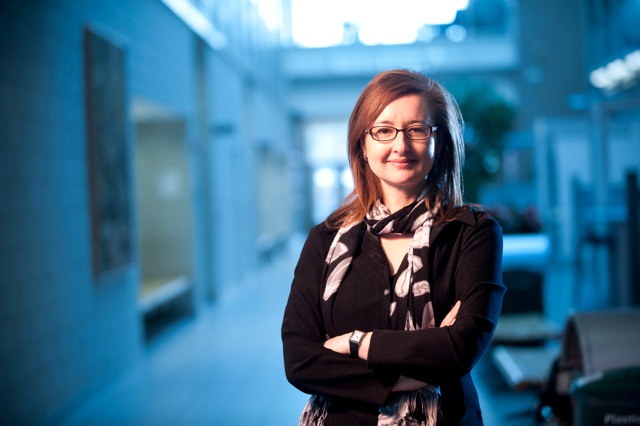For decades, experts suspected that germs recognised as Geobacter could thoroughly clean up radioactive uranium waste, but it was not apparent how the microbes did it.

MSU Professor Gemma Reguera
“The organic system of how they ended up undertaking this remained elusive for 20 yrs,” stated Gemma Reguera, the Spartan microbiologist whose workforce solved that thriller 10 yrs back. Nicely, 3-quarters of the mystery. She’s now cracked the relaxation of the case.
What Reguera learned in 2011 was that, on one particular facet of their cells, the Geobacter make protein filaments that act like little wires to actually zap uranium. This does two points. For one, the jolt triggers chemical reactions that give the germs electricity. Next, that chemistry traps the uranium in a mineral kind, avoiding the radioactive content from spreading by way of the environment.
But all those protein wires accounted for just about 75% of the uranium that the Geobacter ended up cleaning up.
“We constantly realized we ended up missing some thing,” said Reguera, a professor of microbiology and molecular genetics in the Faculty of Natural Science. “What we did not know was what was going on at the cell area, significantly on the facet of the cell that had no wires to immobilize the uranium.”
Now, Reguera’s crew has the answer. Molecules termed lipopolysaccharides coat the mobile surface and soak up the uranium like a sponge.
Revealed on the internet August 4 in the journal Used and Environmental Microbiology, this locating could build new ways not only to remediate unsafe pollution, but also to recycle and reclaim ever more scarce metals from electronics waste. The subsequent phase, Reguera claimed, is investigating whether the Geobacter and their sponges can be inspired to pull other harmful metals from squander streams.

Spartan scientists have uncovered that Geobacter germs — the rod-like designs in this microscope image — package deal uranium into vesicles, which are witnessed as the light-weight specks dotting the image. Credit score: Morgen Clark
“We can request no matter if we can make a process for the selective elimination of metals,” Reguera reported. It would operate kind of like a fermenter, where by breathing microscopic yeast cells make alcoholic beverages, only here, the respiration of Geobacter germs would trap poisonous and crucial metals making use of protein nanowires and the recently found molecular sponges.
As the Geobacter soak up uranium, they also commence packaging it into vesicles, which are bubble-like orbs coated with the lipopolysaccharides. The bacterial cells release the vesicles and replenish their lipopolysaccharide coating to sop up additional uranium.
“It’s a system to transform the mobile surface and assure greatest safety. The cells make some vesicles below regular development circumstances but boost creation to get rid of the trapped uranium. We are now investigating how to scale up vesicle generation,” Reguera mentioned. “We could effectively make a manufacturing unit for these vesicles to pull metals out of drinking water.”
For Reguera, how this discovery was manufactured is as fascinating as the discovery alone. Her team’s protein wire getting in 2011 was published toward the finish of the project’s funding. Starting off up a new investigation into what happened to the other 25% of uranium the Geobacter soaked up would take time.
https://www.youtube.com/enjoy?v=LxaAWbN2koo
Master more about Professor Reguera’s earlier Geobacter research in this video clip from 2012.
Thankfully, there was an undergraduate researcher on Reguera’s workforce, Michael Paxhia, who continued the job with assist from the Faculty of Organic Science and a professorial assistantship. Two graduate pupils, Michael Manzella and Jenna Younger, were so intrigued by the dilemma that they mentored Paxhia even though performing on their different initiatives.
Without having formal funding from a key company, the trio identified the genes accountable for producing Geobacter’s distinctive lipopolysaccharides. Furthermore, if all those genes weren’t working ideal, that would permit uranium into cells, killing the germs.
These lab associates have since graduated: Paxhia is a postdoctoral researcher in the U.K., Manzella is a biology lecturer at Indiana College-Bloomington and Youthful is the co-founder and guide scientist at Fraser Valley Distilling in Colorado.
But their perform created the basis for current doctoral university student Morgen Clark. Clark’s investigate, which is now supported by the Nationwide Science Basis, accomplished the puzzle, demonstrating that Geobacter soaked up the uranium with the lipopolysaccharide sponge and packed it into vesicles.
“This is a tale led by amazingly competent, really enthusiastic pupils,” Reguera said. “I simply cannot inform you how proud I am.”


More Stories
Transforming Appearances with the Perfect Hairpiece Touch
Exploring the Wonders of Modern Sciences
How Sciences Unlock the Mysteries of the Universe